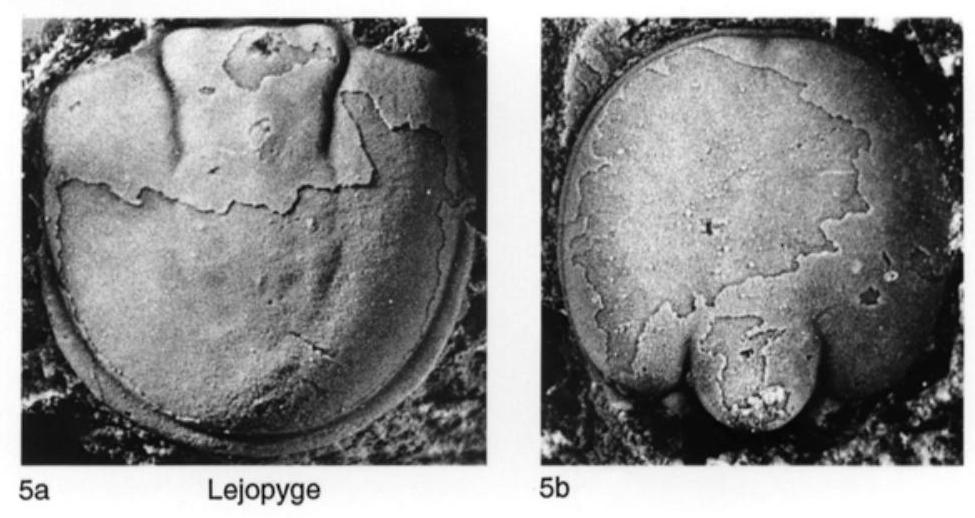Welcome to the Treatise on Invertebrate Paleontology!
Please enter a genera name to retrieve more information.

Onymagnostus
Classification
Phylum:
Arthropoda
Class:
Trilobita
Order:
Agnostida
Superfamily:
Agnostoidea
Family:
Ptychagnostidae
Formal Genus Name and Reference:
Onymagnostus ÖPIK, 1979, p. 107
Type Species:
*O. angulatus; OD; =Agnostus gibbus var. hybridus BRÖGGER, 1878, p. 62; lectotype herein designated (BRÖGGER, 1878, p. 62), 28906, PMO, Oslo
Images
(Click to enlarge in a new window)
Fig. 224,2a,b. *O. hybridus (B RÖGGER), Middle Cambrian (Ptychagnostus punctuosus Zone), Norway (Krekling, Oslo district); a, cephalon, PMO 28088, ×7.5 (new); b, lectotype (here chosen), pygidium, PMO 28096, original syntype of BRÖGGER (1878, pl. 5, fig. 4b), ×7.5 (new).
Synonyms
Onymagnostus
Geographic Distribution
Sweden, Norway, Denmark, T. fissus or A. atavus to L. lundgreni or G. nathorsti Zones; Australia (Queensland, Northern Territory), late T. gibbus to G. nathorsti Zones, (Tasmania), P. punctuosus or G. nathorsti Zone; England, Wales, P. aurora to early P. davidis Zone; Canada (Newfoundland, New Brunswick), P. hicksi to P. forchhammeri Zones; Russia (Siberian Platform), ?Kounamkites Zone, T. fissus or P. hicksi to A. limbataeformis Zones; Kazakhstan, Uzbekistan, Pseudanomocarina Zone; Czechoslovakia, E. pusillus Zone; USA (Utah), T. gibbus Zone, B. contracta Subzone.
Age Range
Beginning Stage in Treatise Usage:
Middle Cambrian
Beginning International Stage:
Cambrian Stage 4
Fraction Up In Beginning Stage:
40
Beginning Date:
512.3
Ending Stage in Treatise Usage:
Middle Cambrian
Ending International Stage:
Guzhangian
Fraction Up In Ending Stage:
50
Ending Date:
498.75
Description
Usually en grande tenue; very strongly convex, particularly in the pygidium; borders in both shields moderately wide; axial furrows variably impressed; median postaxial furrow absent; uncommonly scrobiculate; nonspinose or with very small pygidial marginal spines. Anterior glabellar lobe low, semiovate; posterior glabellar lobe evenly convex, with F2 furrows weak to well developed; glabellar node a short distance behind F2 furrows; basal lobes short to slightly elongate, entire, commonly indistinct anteriorly. Pygidial axis very long, with large node on M2 strongly deflecting F2 furrow; posterior lobe very long, semiovate to subtriangular, narrowly rounded posteriorly.
References
Museum or Author Information
Classification
Phylum:
Arthropoda
Class:
Trilobita
Order:
Agnostida
Superfamily:
Agnostoidea
Family:
Ptychagnostidae
Formal Genus Name and Reference:
Onymagnostus ÖPIK, 1979, p. 107
Type Species:
*O. angulatus; OD; =Agnostus gibbus var. hybridus BRÖGGER, 1878, p. 62; lectotype herein designated (BRÖGGER, 1878, p. 62), 28906, PMO, Oslo
Images
(Click to enlarge in a new window)
Fig. 224,2a,b. *O. hybridus (B RÖGGER), Middle Cambrian (Ptychagnostus punctuosus Zone), Norway (Krekling, Oslo district); a, cephalon, PMO 28088, ×7.5 (new); b, lectotype (here chosen), pygidium, PMO 28096, original syntype of BRÖGGER (1878, pl. 5, fig. 4b), ×7.5 (new).
Synonyms
Onymagnostus
Geographic Distribution
Sweden, Norway, Denmark, T. fissus or A. atavus to L. lundgreni or G. nathorsti Zones; Australia (Queensland, Northern Territory), late T. gibbus to G. nathorsti Zones, (Tasmania), P. punctuosus or G. nathorsti Zone; England, Wales, P. aurora to early P. davidis Zone; Canada (Newfoundland, New Brunswick), P. hicksi to P. forchhammeri Zones; Russia (Siberian Platform), ?Kounamkites Zone, T. fissus or P. hicksi to A. limbataeformis Zones; Kazakhstan, Uzbekistan, Pseudanomocarina Zone; Czechoslovakia, E. pusillus Zone; USA (Utah), T. gibbus Zone, B. contracta Subzone.
Age Range
Beginning Stage in Treatise Usage:
Middle Cambrian
Beginning International Stage:
Cambrian Stage 4
Fraction Up In Beginning Stage:
40
Beginning Date:
512.3
Ending Stage in Treatise Usage:
Middle Cambrian
Ending International Stage:
Guzhangian
Fraction Up In Ending Stage:
50
Ending Date:
498.75
Description
Usually en grande tenue; very strongly convex, particularly in the pygidium; borders in both shields moderately wide; axial furrows variably impressed; median postaxial furrow absent; uncommonly scrobiculate; nonspinose or with very small pygidial marginal spines. Anterior glabellar lobe low, semiovate; posterior glabellar lobe evenly convex, with F2 furrows weak to well developed; glabellar node a short distance behind F2 furrows; basal lobes short to slightly elongate, entire, commonly indistinct anteriorly. Pygidial axis very long, with large node on M2 strongly deflecting F2 furrow; posterior lobe very long, semiovate to subtriangular, narrowly rounded posteriorly.
